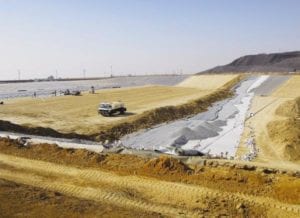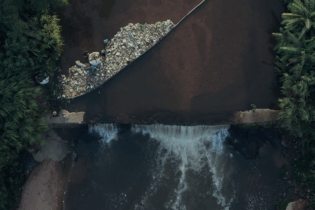The construction of Cell 9 at the Holfontein H:H Disposal Site is the first commercial hazardous waste cell to be designed and constructed to the new Class A standards contained in the Draft National Standard for Disposal of Waste to Landfi ll, Jones & Wagener’s Jonathan Shamrock tells Chantelle van Schalkwyk.
South Africa has seen the publication of numerous pieces of legislation and new regulations pertaining to the environmental engineering and management fields over the past few years. These new regulations are generally more stringent than the legislation they replace,” says Shamrock. He adds that an example is the new landfill barrier design standards. The barrier design standards included in the Department of Water Affairs & Forestry’s Minimum Requirements for Waste Disposal by Landfill (Second Edition, 1998) will be replaced by those in the Draft National Standard for Disposal of Waste to Landfill issued for comment under the National Environmental Management: Waste Act (59/2008) (General Notice 615 of 2012, Government Gazette No 35572 dated 10 August 2012), once finalised and promulgated. “For municipal landfill sites, there will be a significant increase in containment standards with the inclusion of a composite liner consisting of a geomembrane in contact with a low permeability compacted clay liner or geocomposite clay liner. This is especially true for sites that had previously been classified as being in water deficit areas. Hazardous waste landfills now require an additional secondary composite liner similar to the minimum requirements lagoon standards.” Shamrock adds that the inclusion of composite liners in barriers undoubtedly increases the environmental containment standards of these facilities; however, it also introduces potential interface failure planes, especially when applied to slopes, and it increases the complexity, time and cost of construction. “Proper planning during the design phase, including site-specific interface friction testing on the actual geosynthetics to be used with the actual site soil, is vital. There is currently very limited capacity to undertake this test work locally, resulting in the majority of the test work being conducted overseas, adding additional time and cost.” According to Shamrock, multiple composite barrier installation also highlights the importance of full-time quality assurance and quality control during construction. In fact, the need for construction quality assurance will be written into, and be a requirement of, the standard. “The contractor interfaces between the earthworks contractor and the specialist geomembrane installer determine the eventual success of a project, and ensuring quality is managed from design through construction to reduce long-term environmental risk is imperative,” says Shamrock. Class A achievementShamrock says the team at Jones & Wagener is currently nearing completion of the construction of the latest landfill cell, Cell 9, at the Holfontein H:H Disposal Site (Holfontein) in Gauteng owned by EnviroServ Waste Management. The cell is the first commercial hazardous waste cell to be designed and constructed to the new Class A standards contained in the Draft National Standard for Disposal of Waste to Landfill and is five hectares in area. The cell is being constructed by Fountain Civil Engineering and the geomembrane liners are being installed by Engineered Linings. “As much as the addition of a composite liner in the secondary system offers improved environmental protection, it yields some complications in the design and construction of such liners,” warns Shamrock, adding that issues that had to be overcome included ensuring stability of the barrier package using textured geomembrane liners; providing an effective seal to the gravity drainage systems, which had to penetrate the barriers ; and ensuring a practical arrangement of anchoring trenches for the multiple geosynthetic elements used in the design. However, these challenges were taken in stride by the team at Jones & Wagener, which was uniquely suited to the project because of its over-25 years of experience with barrier design in its Waste and Tailings Division, says Shamrock. “We also have a strong geotechnical basis for materials selection, application and analysis in our Geotechnical Division. Due to the nature and scope of the changes in environmental legislation, we have recognised the importance of having dedicated specialist teams in our Environmental Sciences and Environmental Engineering divisions that are tasked with keeping abreast of the changes and then passing this information on to our clients and to our designers to ensure they are incorporated into our designs.”
Additionally, the team has also seen the benefits of a multidisciplinary approach to design, says Shamrock, and therefore ensures that constant feedback of monitored performance from its Environmental Sciences Division, which undertakes water quality monitoring, is incorporated into future designs.
Prioritising rehabilitation“Jones & Wagener is focusing on undertaking more rehabilitation work, especially projects using geosynthetics in rehabilitation,” continues Shamrock. He adds that based on a regulator and industry workshop conducted at the end of 2011, revised standards for the capping of waste facilities are also expected. “The new standards will undoubtedly contain geosynthetic elements. Again, the containment barrier philosophy will have to be applied with particular emphasis on interface friction design and the drainage of pressures below and on top of the geosynthetic elements in the cap to mitigate the risk of veneer failures.” Shamrock says the team at Jones & Wagener is also excited about the opportunity to work on general and hazardous waste disposal facilities in other African countries and apply the knowledge and skills they have learned in South Africa to these projects, which often have unique countryspecific challenges. Staying focused
“Keeping abreast of the latest developments, especially in the field of geosynthetics, is obviously one of our key focus areas,” he says. Jones & Wagener has a significant involvement in the Geosynthetics Interest Group of South Africa (GIGSA), including the immediate past president and the current president, who are employees of Jones & Wagener. “This ensures we are at the forefront of international best practice standards.” According to Shamrock, the next big challenge is applying what the team has learned in barrier design and construction on landfills to waste streams that now need suitable environmental containment as a result of their contaminating potential and in keeping with new legislation, such as ash disposal facilities and mine residue deposits. “Jones & Wagener has a sound knowledge of these waste streams as well as the operational methods used in their deposition through our involvement in these fields in the past, the new facet being the interaction of these facilities with geosynthetic materials, especially composite barriers.” Shamrock adds that in order to highlight the current state of the art and explore these potential challenges, the Landfill 2013 conference is being organised for later this year. The conference theme is ‘Effective environmental protection from the residues of modern civilisation’ and it is being cohosted by the Landfill Interest Group of the IWMSA’s Central Branch and GIGSA on 16 and 17 October 2013 at the Misty Hills Conference Centre in Muldersdrift, Johannesburg. The conference will be followed by a one-day short course on geosynthetic barriers presented on 18 October by Dr George Koerner of the Geosynthetic Institute in Folsom, Pennsylvania, in the US. Dr Koerner will also present the keynote address on the first day of the conference, titled ‘Geosynthetics in Containment: Past, Present and Future’. “As vice chairman of the IWMSA Central Branch and chairman of the Landfill 2013 organising committee, I am very excited to be bringing one of the major contributors to geosynthetics research in the world to South Africa. I would like to encourage all IWMSA and GIGSA members to attend this event,” concludes Shamrock.








